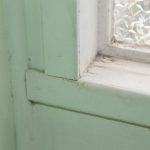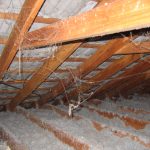WHAT CONSTITUTES A WORKPLACE?
A workplace is a place where work is carried out for a business or undertaking and includes any place where a worker goes, or is likely to be, while at work. A workplace may be a home or property that is undergoing renovations, maintenance or demolition. A worker may be an owner-builder, DIY renovator, handy man or a tradesperson engaged to conduct work on a domestic property.
It’s vital that anyone working on domestic properties learn to identify areas where asbestos might be located and how to manage it safely and it’s recommended that Tradies and handymen undergo Asbestos Awareness and Management training.
WHEN DOES ASBESTOS BECOME DANGEROUS TO PEOPLE IN THE WORKPLACE?
If well maintained and in a stable, good condition, asbestos products are unlikely to release dangerous fibres and pose a health risk. However, asbestos becomes a health risk when:
- Fibres that become airborne and breathed in can cause asbestos-related diseases including mesothelioma, lung cancer, plural disease and asbestosis.
- Asbestos fibres become airborne when asbestos containing materials are damaged or broken, cut, drilled, sawn, sanded scraped, waterblasted or disturbed during demolition.
- Using tools, particularly power tools which can release a high concentration of fibres into the air that can be inhaled.
WHAT TYPES OF ASBESTOS MIGHT BE FOUND IN DOMESTIC PROPERTIES
There are two types of asbestos building materials: “non-friable” and “friable”.
Non-Friable Asbestos is any material (other than friable asbestos) that contains asbestos. Non-friable asbestos cannot be crumbled, pulverised or reduced to a powder by hand pressure when dry.

- Products containing non-friable asbestos can be found anywhere! Common uses in residential buildings include: asbestos cement (AC) sheeting (fibro) which may be flat or corrugated and used internally and externally as roofing, fencing, wall and floor coverings, for water drainage and guttering, flue pipes and in wet or high temperature areas.
- Asbestos products don’t need to be removed if sealed, in good, stable condition and left undisturbed, because they are unlikely to release dangerous fibres posing health risks.
Friable Asbestos is any material containing asbestos in the form of a powder or can be crumbled, pulverised or reduced to powder by hand pressure when dry.
- Friable asbestos was mainly used in industrial applications but non-friable asbestos can become friable if damaged, unsealed and exposed to weather.
- ONLY Class A Licenced Asbestos Removalists can remove friable asbestos.

Friable Asbestos: e.g. Loose-fill ‘Mr Fluffy’
Loose-fill (Mr Fluffy) asbestos insulation was installed in ceilings in some homes in NSW and the ACT between 1968 and 1979. It was made of crushed, loose (friable) asbestos and then pumped (and possibly spread) into the ceiling space as insulation. If disturbed it could migrate to wall cavities and sub-floor areas. However the risk of exposure to asbestos in buildings containing loose-fill asbestos is likely to be very low if the asbestos is undisturbed and sealed off.
- If you are working in NSW or the ACT, NEVER enter ceiling or sub-floor space before contacting Council to see if the property is located in an area affected by Mr Fluffy.
- Contact Council, NSW Fair Trading Asbestos Task Force or the ACT Government’s Asbestos Task Force to check if a property might be located in an affected Council region before entering ceiling or sub-floor space!
IMPORTANT
Do not enter ceiling space or subfloor areas if a home is located in council regions that have been identified as loose-fill regions. Contact the local Council, NSW Fair Trading or ACT Government Asbestos Task Force.
DO TRADIES NEED A FORMAL ASBESTOS REGISTER AND MANAGEMENT PLAN WHEN WORKING ON RESIDENTIAL PROPERTIES?
Only when a premises has been defined as a workplace. For more information contact the Council or State or Territory Government to find out if you need to have a formal Asbestos Register and Management Plan.
ARE THERE LEGAL REQUIREMENTS FOR MANAGING ASBESTOS SAFELY?
Yes. There are legal requirements regarding asbestos management, its removal and disposal which can vary from state to state. Be sure to check with Council or the relevant State or Territory Government for legal requirements.
- While some Tradies might follow the regulations and safety requirements to remove small amounts of asbestos, the safest way to manage its removal is to retain a licenced professional asbestos removalist equipped to protect those living and working on a residential property from the dangers of asbestos dust and fibres.
- The cost of professional removal by a licenced professional is comparable to most licenced tradesmen including electricians, plumbers and tilers.
- The cost of disposal at a lawful site is often included with the cost of removal by a licenced professional.
WARNING
It’s vital that Tradies manage asbestos safely and follow the regulations in each State and Territory. There are potential clean-up costs and reputational damage that can be caused if asbestos is mishandled or if asbestos materials are illegally dumped.
WHO SHOULD REMOVE AND DISPOSE OF ASBESTOS-CONTAINING MATERIALS?
If asbestos products need to be removed, it’s recommended that Tradies use licenced asbestos removalists trained to remove and dispose of asbestos safely. The cost of engaging a professional licenced asbestos removalist is comparable to other licenced tradespersons including electricians, plumbers and tilers.
Which Licenced asbestos removalists should remove asbestos materials?
There are 2 types of Asbestos Removal Licences: Class A and Class B.
- Class A Licence can remove all types of asbestos including Friable (crumbly material).
- Class B Licence can only remove non-friable (solid) asbestos materials.
Regulations about asbestos removal vary from state-to-state. Contact the regulator in your State or Territory to ensure you follow regulations.
Share this information on:

